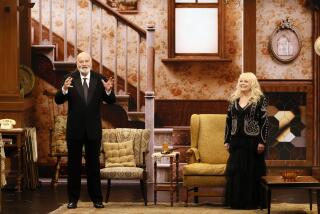Norman Lear’s Declaration and the battle for the Constitution
- Share via
A couple of years ago, I was invited to be nose to nose with history.
No more than 30 of the original 200 copies of the Declaration of Independence survive, and no more than half a dozen of those are outside museum walls. They were all printed in Philadelphia on the night of July 4, 1776 -- the date may ring a bell with you.
And there one was, astoundingly, right in front of me, in a climate-sealed case, lying on a table so low that I had to kneel down to gaze at the Declaration properly. A sheet of glass was all that separated me from this breathtaking memento of a watershed moment of history, and there, so close that my breath could have fogged the glass, 23 decades fell away to the thin conceit of time. Had this copy been sent to one of the Colonies, the way we’d cc an important email today, or to Gen. George Washington leading a fledgling American army in the field?
Here, Americans, was your original birther document -- the nation’s birth certificate. It spawned others, chiefly the Constitution of the United States, which is revered and disputed even by those who haven’t read it, or not read beyond the first few choice and contentious amendments.
The Declaration of Independence I saw then belongs to TV producer Norman Lear. He bought it and sent it on a tour to schools and museums. It had made a brief stop at his Los Angeles house before setting off on tour again, and it was there that I was invited to see it so intimately.
Americans of all political dispositions quote the Declaration with the same regard about its meaning. But the Constitution, we tend to roll up (metaphorically) and whack our political opponents with, never more than during an election year, when candidates all claim the constitutional higher ground yet make blood sport of disputing exactly what the Constitution means, each arguing that he, not the other guy, loves America most.
I talked about the Constitution with Lear for my column. A couple of years after his influential “All in the Family” show went off the air in 1979, he founded People For the American Way, and he spoke at its gala in Washington this week.
Some email responses to my column made me wonder whether, 20-some decades ago, the battles over the meaning of the Constitution and politics raged as venomously and personally beneath those fancy waistcoats as they do now, when every last little thing gets mashed through a political mangle. One was so near parody that I thought it was, until I realized it wasn’t: “I would have asked [Lear] … What does MSNBC, LA/NY TIMES and the 3 networks and a Marxist prez mean to this country’s politics?”
What I did ask Lear was about Texas Democratic congresswoman Barbara Jordan -- a black woman who wouldn’t have been welcome at the 18th century Constitutional Convention unless she’d had a mop and pail. This is what she famously said during the Watergate hearings: that her faith in the Constitution -- a document that originally had no place for her -- was “whole. It is complete. It is total.”
Did that, I wonder, characterize Lear’s faith and hope in a document over which people who say they love it also engage in a tug-of-war over its meaning that sometimes seems to threaten to pull it apart?
“I don’t wish to wake up in the morning if I have no hope. Hope is a big part of my being. There’s a wall between me and the people who are throwing rocks, and it’s glass. They’re throwing rocks at the Constitution, and we have to be strong enough to turn them back.”
Just wait and watch: There’s little doubt that his philosophical opposites believe exactly the same thing, from their 180-degree different vantage point. It’s election season, Jake.
RELATED:
Norman Lear at the Playboy Mansion
More to Read
A cure for the common opinion
Get thought-provoking perspectives with our weekly newsletter.
You may occasionally receive promotional content from the Los Angeles Times.










